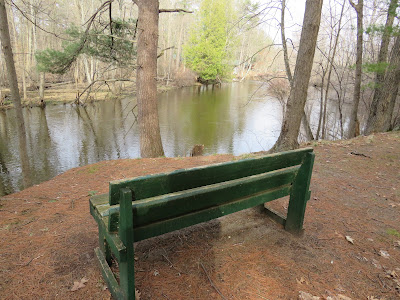The morning temperatures are in the upper 50’s with a gentle north wind while the sun shines through a hazy sky as I begin hiking on a nature trail in Lumberjack Park. Heading north over the boardwalk, I spot a few Skunk Cabbage sprouts, a sure sign of spring. Crossing the bridge over Mud Creek, I pause to watch its water flow gently west toward a confluence with the Pine River. Off in the distance, a small group of foraging Wild Turkey catch my eye. Continuing through a pine forest, I come upon a tree trunk with a woodpecker hole occupied by the web of a Funnel Weaver spider (stock photo). Arriving at the edge of the Pine River, I watch its water flow by while being serenaded by a Northern Cardinal. After passing the Keeler overlook, my ears perk up to a duet of a Black-capped Chickadee and Tufted Titmouse. While crossing the Lumberjack Rd. bridge, I spot a highly decomposed deer carcass. Looking more closely, I spot a ½ -inch American Carrion Beetle that gets its name from the prominent role that flesh of dead animals plays in its existence. These beetles and other decomposers are important because they get rid of dead matter by consuming it. They can fly to carrion up to 1.5 miles away by using olfactory organs located on their antennae. They usually arrive during the early to middle stages of carcass decomposition and lay eggs on or near the carcass. Their young then feed on the fly larvae that are present on the carcass. Carrion beetles also have chemical defenses. They secrete a strong, smelly odor that irritates other bugs and small animals. They can even spray the odor at predators to keep them away. Also, I notice several ¼-inch green Ham Beetles on the carcass. Possibly native to northern Africa, having been found in Egyptian mummies, they are now found throughout the world. Ham beetles also feed on animal products in processes such as taxidermy, where they may be a nuisance as they feed within antlers or other residual meat materials. Their life cycle can be completed in as little as 30 days – 17 days as a larva and 13 days in pupation. Adults are rather long-lived, surviving up to one year or longer, and several generations can be produced each year. Turning east to hike along the riverbank, I notice, up ahead, how the morning sunlight reflects off the rippling water. Heading back to the car past the campground, I pause one final time to hear the song of a White-breasted Nuthatch.
High in azure blue
Or low without snow
Honk of a Canada goose
Caw of a Common Crow
Noisy Jay of blue
Chipping Cardinal of red
White breast of a Chickadee
Black cap on its head
Some perch in stillness
Other ones in flight
Nature’s winged wonders
April’s morning light
D. DeGraaf

No comments:
Post a Comment